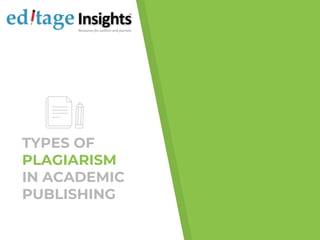
Types of plagiarism in academic publishing
- 3. PICTURE THIS SCENARIO: Halfway into your research project, you find that another group of researchers – Jones et. al. – has elegantly described the stages through which a disease advances. 3 You feel that you cannot possibly describe the stages better than Jones et. al. and decide to use it word-for-word in your paper.
- 4. 4 But can you do this? Is it acceptable to use Jones et. al.’s work as is? ABSOLUTELY NOT! Attempting to use the ideas, words, or work done earlier by someone else, without giving them due credit, is known as “plagiarism.” And plagiarism is considered extremely unethical.
- 5. 5 SO DOES THIS MEAN YOU CAN NEVER CITE THE WORK OF OTHER RESEARCHERS? You can cite another researcher’s work, as long as you do so ethically and give them due credit. HOW CAN YOU ETHICALLY CITE ANOTHER RESEARCHER’S WORK? By clearly and completely acknowledging all the sources you have referred to while conducting your research or writing your paper.
- 6. 2. WHAT ARE THE TYPES OF PLAGIARISM?
- 7. HERE ARE 4 COMMON TYPES OF PLAGIARISM: 7 ▸ Deliberate plagiarism ▸ Accidental or unwitting plagiarism ▸ Self-plagiarism ▸ Mosaic plagiarism
- 8. 8 DELIBERATE PLAGIARISM OCCURS WHEN: ▸ You don’t give due credit to previously published work in your field and instead present this previous work as your own ideas. ▸ You don’t credit the techniques you have used to conduct your research to the people who originally developed them. ▸ You pass off the opinions and ideas of others as your own.
- 9. 9 WHY DO RESEARCHERS DELIBERATELY PLAGIARIZE WORK? Time constraints or poor time management could push a researcher to plagiarize large chunks of material from other authors
- 10. 10 ACCIDENTAL OR UNWITTING PLAGIARISM OCCURS WHEN: ▸ You don’t think that it is necessary to acknowledge the original author of a well-known fact, considering it as “common scientific knowledge” (e.g., global warming is causing climate change). ▸ You make a careless oversight or error while writing down references. For instance, you may have forgotten to cite a source or incorrectly cited it. ▸ There is a cultural difference; for instance, junior researchers from certain cultures may feel that it is disrespectful to alter the words used by a senior researcher who is an authority in the field.
- 11. 11 ACCIDENTAL OR UNWITTING PLAGIARISM OCCURS WHEN: ▸ There are language problems; for instance, if English is not your first language, you may not be confident of your ability to paraphrase another researcher’s work while retaining the original meaning. ▸ The original article is a highly technical description, and you feel incapable of paraphrasing it in your own words. This is especially true for students or inexperienced researchers.
- 12. SELF-PLAGIARISM OCCURS WHEN: 12 ▸ You republish one of your existing articles either in its entirety or reuse portions of a previously written text while authoring new work. ▸ You combine your previously published papers to create one larger article or even a book without acknowledging the previous articles.
- 13. 13 WHY CAN’T YOU USE TEXT FROM YOUR OWN PUBLISHED WORK? Although you can quote text from your previous publications with relevant citations, a duplicate publication of previously reported data is very unethical. If you engage in self-plagiarism, your new paper could be deemed as a redundant publication. This could lead to copyright infringement.
- 14. 14 MOSAIC PLAGIARISM OCCURS WHEN: ▸ You directly use words or phrases from the source document without enclosing the extracted text in quotes or setting it apart as a block quotation. ▸ You attempt to replace words from the source document with synonyms without changing either the overall structure or the meaning of the original version.
- 16. 16 A reviewer or journal editor easily detects plagiarism if they find that a submitted manuscript contains: Large passages quoted verbatim from the source document Large amounts of text from the source document with very little modification “
- 17. What leads reviewers to think that authors have plagiarized previously published work? Reviewers get suspicious if: ▸ the author’s writing style varies considerably between passages in the submitted manuscript ▸ the level of English used is very different in different parts of the manuscript ▸ the reviewer is familiar with the work that has been plagiarized 17
- 18. 4. WHAT ARE THE CONSEQUENCES OF PLAGIARISM?
- 19. 19 IF YOUR ARE FOUND PLAGIARIZING OTHER WORK: ▸ you could lose tenure/funding ▸ you could lose credibility in the academic community for the entire body of your work. REMEMBER: Don’t take plagiarism lightly. If a journal detects any plagiarism in your paper, regardless of your intent, you won’t be absolved.
- 20. 20 REFERENCES ▸ Plagiarism in academic publishing https://www.editage.com/insights/plagiarism-in-academic- publishing ▸ What’s the big deal about self-plagiarism? https://www.editage.com/insights/whats-the-big-deal-about-self- plagiarism ▸ The common types of plagiarism https://www.bowdoin.edu/studentaffairs/academic- honesty/common-types.shtml ▸ RoigM (2006). Avoiding plagiarism, self-plagiarism, and other questionable writing practices: A guide to ethical writing https://ori.hhs.gov/sites/default/files/plagiarism.pdf
- 21. www.editage.com/insights @EditageInsights Connect with us For more useful resources and tips on publication, visit:
